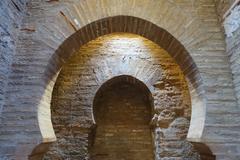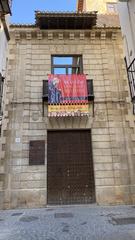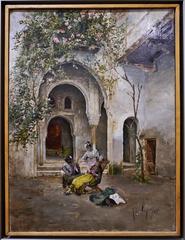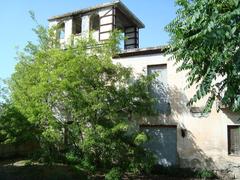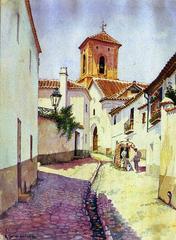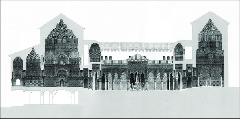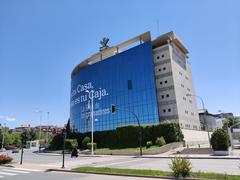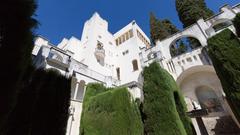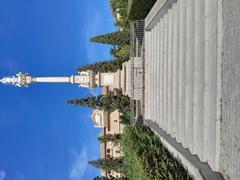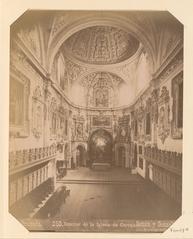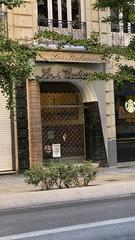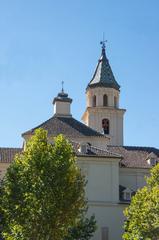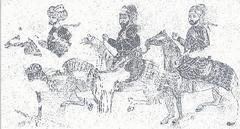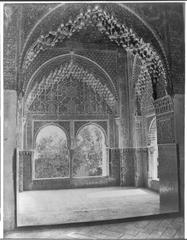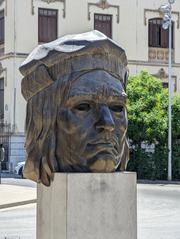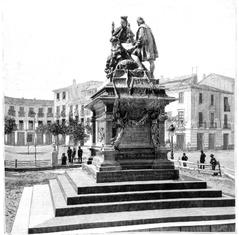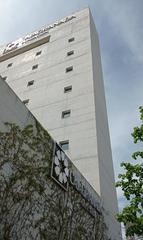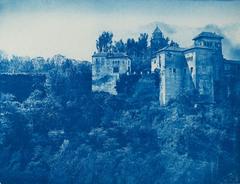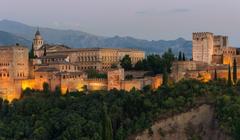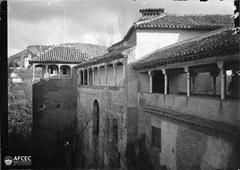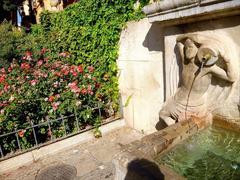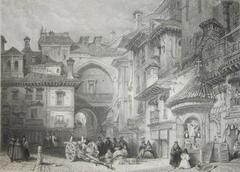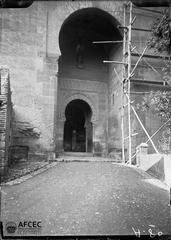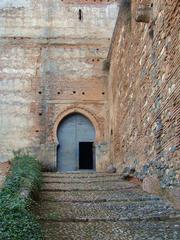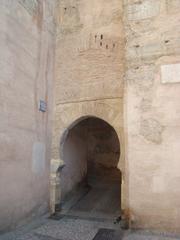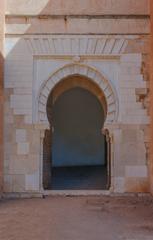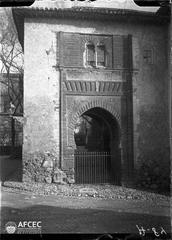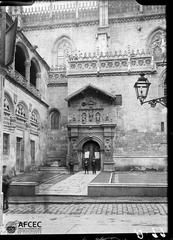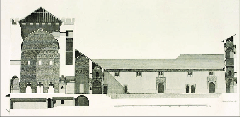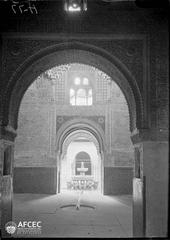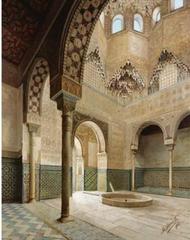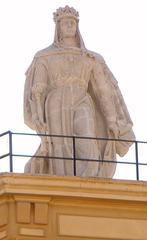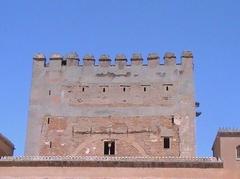Plaza del Campillo Granada: Visiting Hours, Tickets, and Historical Sites Guide
Date: 14/06/2025
Introduction: History and Significance
Plaza del Campillo is a vibrant square nestled in the heart of Granada, Spain. Celebrated for its rich history and central role in Granada’s cultural life, the plaza has evolved from fields on the city’s medieval outskirts to a bustling social hub. Its strategic location near key landmarks such as Granada Cathedral and the Alhambra, and its historical function as a site for military gatherings and political movements, make it a quintessential destination for travelers seeking to immerse themselves in the city’s layered heritage (Hey Granada; Cámaras y Objetivos; LoveGranada).
The square is open 24 hours a day with free public access, attracting locals and tourists alike. It is notable for its Andalusian architecture, the ornate Baroque Fountain of the Battles, and the statue of Mariana Pineda, a heroine of Spanish liberalism. Plaza del Campillo is also renowned for its vibrant tapas scene, lively nightlife, and frequent cultural events, offering an authentic window into Granada’s social vitality (Hey Granada; Cámaras y Objetivos).
Contents
- Origins and Early History
- The Fountain of the Battles: Military and Civic Pride
- 19th–20th Century Transformation
- Contemporary Role as a Cultural Hub
- Architectural Features and Urban Evolution
- Visiting Information: Hours, Tickets, and Accessibility
- Social and Cultural Importance
- Events and Traditions
- Notable Monuments and Historical Figures
- Dining, Nightlife, and Gastronomy
- Practical Visitor Tips
- Nearby Attractions
- Guided Tours and Visitor Services
- Sustainability and Responsible Tourism
- FAQs
Origins and Early History
Plaza del Campillo’s origins trace back to Roman and Arab settlements, evidenced by archaeological findings that highlight its role as a crossroads for various cultures (Hey Granada). In the Middle Ages, it marked the boundary between Granada’s fortified core and expanding suburbs, serving as a space for commerce, military gatherings, and communal events. The name “Campillo,” meaning “little field,” reflects its beginnings as open land that gradually urbanized as Granada grew in prominence.
The Fountain of the Battles: Military and Civic Pride
A defining feature of the square is the Baroque Fountain of the Battles (Fuente de las Batallas). Historically, it was the site where Granada’s army assembled for inspections before military campaigns or ceremonies, instilling the square with civic and military pride. Today, it remains a focal point for local celebrations, including football victories and citywide festivities (Hey Granada).
19th–20th Century Transformation
The 19th century saw Plaza del Campillo become a center for political and social change. The statue of Mariana Pineda, executed in 1831 for her defense of liberal ideals, marks the square’s connection to Spain’s fight for constitutional freedoms. The area also developed culturally with the construction of cafés, shops, and the Isabel la Católica Theater—a testament to Granada’s 19th-century urban and artistic renewal (Hey Granada; Mapa de la Memoria Histórica de Granada).
In the 20th century, the plaza became a hub for celebrations and gatherings. It remains the scene of vibrant Christmas markets, Holy Week processions, and year-round social life (The Travel; Seda Club Hotel).
Contemporary Role as a Cultural Hub
Today, Plaza del Campillo is a lively center for performances, street musicians, and artistic events. Its perimeter features popular tapas bars, ice cream shops, and the iconic Café Fútbol. The square is a preferred spot for both quiet relaxation in the morning and bustling nightlife in the evenings, serving as a genuine reflection of Granada’s dynamic culture (Cámaras y Objetivos; Evendo).
Architectural Features and Urban Evolution
The plaza is encircled by well-preserved buildings from the 19th and early 20th centuries, featuring classic Andalusian facades and wrought-iron balconies. The Isabel la Católica Theater, inaugurated in 1952, adds a neoclassical touch and hosts a variety of cultural performances, enhancing the square’s artistic appeal (Hey Granada). The square’s open layout, mature trees, and shaded benches foster a welcoming atmosphere for community interaction.
Visiting Information: Hours, Tickets, and Accessibility
- Hours: Open 24/7 with free public access.
- Tickets: No tickets required for the square itself. Nearby venues such as the Isabel la Católica Theater may charge for events; check their official website for details.
- Accessibility: The plaza is wheelchair-friendly, with smooth paving and curb cuts. Most cafés and restaurants are accessible, though some adjacent streets may be cobbled or sloped (LoveGranada; Nomadic Matt).
Social and Cultural Importance
Plaza del Campillo serves as a daily meeting place for locals, a route for processions, and a venue for open-air markets and performances. Its centrality ensures it is always lively, particularly during festivals like Holy Week and Corpus Christi (Seda Club Hotel). The square’s role as a community hub is vital to Granada’s urban identity (Evendo).
Events and Traditions
Key annual events include:
- Holy Week Processions: Elaborate religious parades pass through the square, drawing thousands of spectators (Seda Club Hotel).
- Markets and Fairs: Artisan markets and seasonal festivals offer crafts, gastronomy, and local products.
- Cultural Performances: Street musicians and performers enliven the plaza year-round (Evendo).
Notable Monuments and Historical Figures
- Statue of Mariana Pineda: A symbol of Granada’s liberal legacy and political history (Hey Granada).
- Fountain of the Battles: The square’s Baroque centerpiece.
- Isabel la Católica Theater: A cultural institution hosting music, dance, and theater.
Dining, Nightlife, and Gastronomy
Granada is famed for its tapas tradition—order a drink at any bar around the plaza and receive a complimentary tapa (Andalucia In My Pocket). Bar Avila, Café Fútbol, and Heladería Los Italianos are local favorites. Outdoor terraces offer al fresco dining and a front-row seat to the city’s vibrant social scene (Cámaras y Objetivos; The Crazy Tourist).
Practical Visitor Tips
- Transport: Easily accessible by foot from major landmarks; nearest bus lines include SN1, SN4, and C3. Limited parking nearby; public transport is recommended (LoveGranada).
- Best Visiting Times: Late afternoons and evenings for atmosphere; mornings for tranquility. Spring and autumn offer the most pleasant weather (Nomadic Matt).
- Amenities: Shaded benches, outdoor seating, and nearby cafés with restroom facilities. Most establishments provide Wi-Fi for customers.
- Accessibility: Flat terrain with occasional gentle slopes; wheelchair accessible.
- Safety: The area is safe and well-frequented. As with any tourist area, keep an eye on personal belongings.
Nearby Attractions
- Granada Cathedral & Royal Chapel: 7-minute walk; masterpieces of Renaissance architecture (Nomadic Matt; Voyage Tips).
- Albayzín: Historic Moorish quarter with panoramic views, 15 minutes away (Lonely Planet).
- Alhambra: Granada’s iconic palace complex, 20 minutes on foot.
- Realejo: The Jewish quarter, famous for street art, tapas bars, and local history.
Guided Tours and Visitor Services
Guided walking tours of Granada’s historic districts frequently include Plaza del Campillo. Inquire at the Granada Tourist Office or local hotels for schedules and multilingual options. The office at Plaza del Carmen is a short walk away and provides maps, event calendars, and assistance.
Sustainability and Responsible Tourism
Support local businesses, dispose of litter responsibly, and respect siesta hours (2:00–5:00 pm). Responsible tourism helps maintain the unique character of Plaza del Campillo and its community.
Frequently Asked Questions (FAQs)
Q: Is there an entrance fee or ticket required?
A: Plaza del Campillo is open to the public 24/7 and is free to visit.
Q: What are the best times to visit?
A: Late afternoons and early evenings are busiest and most atmospheric. Mornings are quieter.
Q: Are there guided tours?
A: Yes, many city walking tours feature Plaza del Campillo.
Q: Is it accessible for wheelchairs and strollers?
A: Yes, though some nearby streets may have cobbles or gentle slopes.
Q: Are there public restrooms?
A: No, but local cafés and restaurants offer facilities for customers.
Q: Where can I find emergency help?
A: Dial 112 for emergency services. Pharmacies and the Tourist Police are nearby.
Visual Highlights (Image Suggestions)
- Central Fountain: “Plaza del Campillo central fountain in Granada”
- Statue of Mariana Pineda: “Monument to Mariana Pineda in Plaza del Campillo, Granada”
- Outdoor Cafés: “Outdoor terraces at Plaza del Campillo with visitors”
- Panorama: “View of Granada Cathedral near Plaza del Campillo”
Conclusion
Plaza del Campillo offers a unique blend of Granada’s history, culture, and daily life. Its open, welcoming atmosphere provides a tranquil retreat and a vibrant social hub, while its proximity to the city’s most famous landmarks makes it a convenient base for exploration. Whether you seek historical insight, culinary delights, or a lively local scene, Plaza del Campillo is an essential stop in any Granada itinerary.
For more travel tips, event updates, and guided tour bookings, download the Audiala app and explore our related articles. Join us on social media for the latest news and share your experiences with #AudialaTravel.

